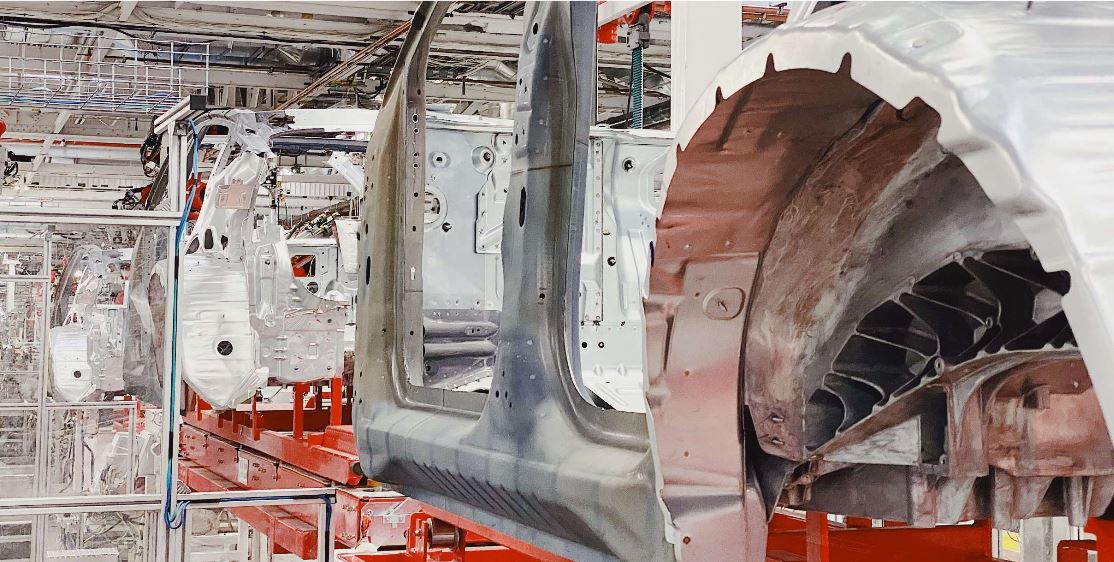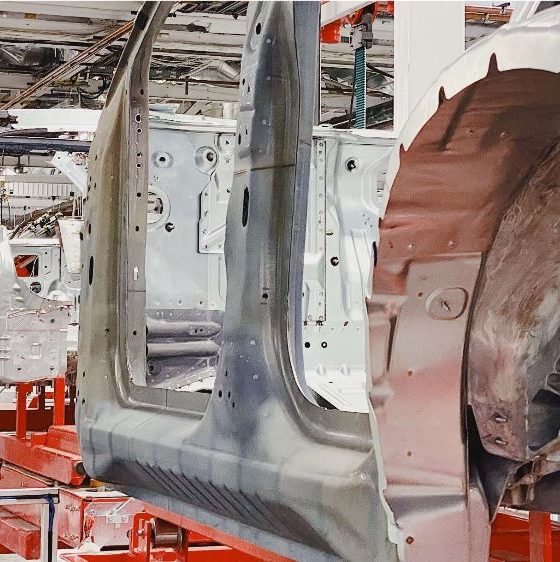

News
Tesla’s Elon Musk talks Model Y production quality in leaked email
A recently leaked e-mail from Tesla CEO Elon Musk has indicated the Model Y production ramp is now of utmost priority at the Fremont production plant. Musk personally offered his assistance to employees at the Fremont facility and thanked members of General Assembly 4 (GA4), the production line where the Model Y is built.
Musk has indicated that the Fremont production facility’s main priority for the foreseeable future is the ramp of the Model Y. In the e-mail obtained by Business Insider, Musk suggests that the production of the Model S, X, and 3 are going “reasonably well,” but the Y is experiencing supply chain ramp challenges, which are expected with new products.
However, the CEO indicated that the successful production process of the Model Y comes down to eliminating errors and increasing efficiency. “I want you to know that it really makes a difference to Tesla right now,” Musk writes to employees.
Tesla will now make the Model Y a top priority for both production and manufacturing engineering, the e-mail says.
The current production line where the Model Y is built is GA4, which is an outdoor tent that sits next to the Fremont facility. Previously, the Model 3 was constructed on this line and was eventually built 5,000 sedans a week. Much like the Model Y’s current roadblocks, the Model 3 also encountered problems at the beginning of its eventually-successful ramp up stage.
Musk once referred to the rough patch in the Model 3 ramp as “production hell.” Tesla encountered issues in building a large number of Model 3’s during Q2 2018, where the company struggled with building efficiencies and suitable production methods. To combat this issue, Tesla built a third line for the Model 3, which eventually became GA4.
Eventually, the production issues subsided, and Tesla reached a build rate of 5,000 Model 3s a week. It is only a matter of time before the company replicates this with the Model Y and begins a sizeable production effort in Fremont.
Tesla was performing the initial deliveries of the Model Y when the Fremont facility was shut down due to the COVID-19 pandemic. After the production plant was reopened in May, workers had to readjust to the manufacturing process, which is understandable after a month and a half layoff. Delays could simply be due to human adjustment or because the production of a new car comes with an expected ramping period.
Eventually, Tesla will figure out the issues and delays and become more efficient with the Model Y. Luckily, support from Musk is evident. “Please let me know if there’s anything I can do to help,” he concluded in the e-mail.
The full message to Fremont employees is available below.
Subject: Model Y production
It is extremely important for us to ramp up Model Y production and minimize rectification needs. I want you to know that it really makes a difference to Tesla right now.
Model Y, especially GA (stands for General Assembly), is the top priority for both production and manufacturing engineering. GA4 (stands for General Assembly Line 4) is also top priority for facility improvements. For those working in GA4, thank you for bearing with tough conditions. Will get better fast. I will be walking the line personally every week.
We are doing reasonably well with S, X, and 3, but there are production and supply chain ramp challenges with Model Y, as is always the case with new products.
Please let me know if there’s anything I can do to help.
Thanks,
Elon

Elon Musk
Elon Musk and Tesla AI Director share insights after empty driver seat Robotaxi rides
The executives’ unoccupied tests hint at the rapid progress of Tesla’s unsupervised Robotaxi efforts.

Tesla CEO Elon Musk and AI Director Ashok Elluswamy celebrated Christmas Eve by sharing personal experiences with Robotaxi vehicles that had no safety monitor or occupant in the driver’s seat. Musk described the system’s “perfect driving” around Austin, while Elluswamy posted video from the back seat, calling it “an amazing experience.”
The executives’ unoccupied tests hint at the rapid progress of Tesla’s unsupervised Robotaxi efforts.
Elon and Ashok’s firsthand Robotaxi insights
Prior to Musk and the Tesla AI Director’s posts, sightings of unmanned Teslas navigating public roads were widely shared on social media. One such vehicle was spotted in Austin, Texas, which Elon Musk acknowleged by stating that “Testing is underway with no occupants in the car.”
Based on his Christmas Eve post, Musk seemed to have tested an unmanned Tesla himself. “A Tesla with no safety monitor in the car and me sitting in the passenger seat took me all around Austin on Sunday with perfect driving,” Musk wrote in his post.
Elluswamy responded with a 2-minute video showing himself in the rear of an unmanned Tesla. The video featured the vehicle’s empty front seats, as well as its smooth handling through real-world traffic. He captioned his video with the words, “It’s an amazing experience!”
Towards Unsupervised operations
During an xAI Hackathon earlier this month, Elon Musk mentioned that Tesla owed be removing Safety Monitors from its Robotaxis in Austin in just three weeks. “Unsupervised is pretty much solved at this point. So there will be Tesla Robotaxis operating in Austin with no one in them. Not even anyone in the passenger seat in about three weeks,” he said. Musk echoed similar estimates at the 2025 Annual Shareholder Meeting and the Q3 2025 earnings call.
Considering the insights that were posted Musk and Elluswamy, it does appear that Tesla is working hard towards operating its Robotaxis with no safety monitors. This is quite impressive considering that the service was launched just earlier this year.
Elon Musk
Starlink passes 9 million active customers just weeks after hitting 8 million
The milestone highlights the accelerating growth of Starlink, which has now been adding over 20,000 new users per day.

SpaceX’s Starlink satellite internet service has continued its rapid global expansion, surpassing 9 million active customers just weeks after crossing the 8 million mark.
The milestone highlights the accelerating growth of Starlink, which has now been adding over 20,000 new users per day.
9 million customers
In a post on X, SpaceX stated that Starlink now serves over 9 million active users across 155 countries, territories, and markets. The company reached 8 million customers in early November, meaning it added roughly 1 million subscribers in under seven weeks, or about 21,275 new users on average per day.
“Starlink is connecting more than 9M active customers with high-speed internet across 155 countries, territories, and many other markets,” Starlink wrote in a post on its official X account. SpaceX President Gwynne Shotwell also celebrated the milestone on X. “A huge thank you to all of our customers and congrats to the Starlink team for such an incredible product,” she wrote.
That growth rate reflects both rising demand for broadband in underserved regions and Starlink’s expanding satellite constellation, which now includes more than 9,000 low-Earth-orbit satellites designed to deliver high-speed, low-latency internet worldwide.
Starlink’s momentum
Starlink’s momentum has been building up. SpaceX reported 4.6 million Starlink customers in December 2024, followed by 7 million by August 2025, and 8 million customers in November. Independent data also suggests Starlink usage is rising sharply, with Cloudflare reporting that global web traffic from Starlink users more than doubled in 2025, as noted in an Insider report.
Starlink’s momentum is increasingly tied to SpaceX’s broader financial outlook. Elon Musk has said the satellite network is “by far” the company’s largest revenue driver, and reports suggest SpaceX may be positioning itself for an initial public offering as soon as next year, with valuations estimated as high as $1.5 trillion. Musk has also suggested in the past that Starlink could have its own IPO in the future.
News
NVIDIA Director of Robotics: Tesla FSD v14 is the first AI to pass the “Physical Turing Test”
After testing FSD v14, Fan stated that his experience with FSD felt magical at first, but it soon started to feel like a routine.

NVIDIA Director of Robotics Jim Fan has praised Tesla’s Full Self-Driving (Supervised) v14 as the first AI to pass what he described as a “Physical Turing Test.”
After testing FSD v14, Fan stated that his experience with FSD felt magical at first, but it soon started to feel like a routine. And just like smartphones today, removing it now would “actively hurt.”
Jim Fan’s hands-on FSD v14 impressions
Fan, a leading researcher in embodied AI who is currently solving Physical AI at NVIDIA and spearheading the company’s Project GR00T initiative, noted that he actually was late to the Tesla game. He was, however, one of the first to try out FSD v14.
“I was very late to own a Tesla but among the earliest to try out FSD v14. It’s perhaps the first time I experience an AI that passes the Physical Turing Test: after a long day at work, you press a button, lay back, and couldn’t tell if a neural net or a human drove you home,” Fan wrote in a post on X.
Fan added: “Despite knowing exactly how robot learning works, I still find it magical watching the steering wheel turn by itself. First it feels surreal, next it becomes routine. Then, like the smartphone, taking it away actively hurts. This is how humanity gets rewired and glued to god-like technologies.”
The Physical Turing Test
The original Turing Test was conceived by Alan Turing in 1950, and it was aimed at determining if a machine could exhibit behavior that is equivalent to or indistinguishable from a human. By focusing on text-based conversations, the original Turing Test set a high bar for natural language processing and machine learning.
This test has been passed by today’s large language models. However, the capability to converse in a humanlike manner is a completely different challenge from performing real-world problem-solving or physical interactions. Thus, Fan introduced the Physical Turing Test, which challenges AI systems to demonstrate intelligence through physical actions.
Based on Fan’s comments, Tesla has demonstrated these intelligent physical actions with FSD v14. Elon Musk agreed with the NVIDIA executive, stating in a post on X that with FSD v14, “you can sense the sentience maturing.” Musk also praised Tesla AI, calling it the best “real-world AI” today.








